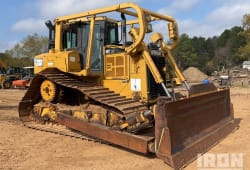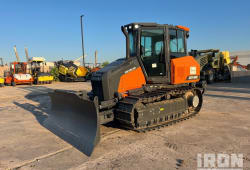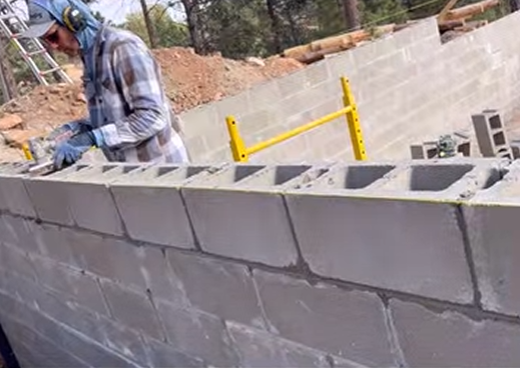Breaking Ground: Unleashing the Power of Bulldozers in Construction
9 Min read
)
January 19, 2024
Bulldozers, often simply referred to as dozers, are heavy-duty machines primarily used for pushing, digging, excavating, and leveling large quantities of soil, sand, rubble, or other such material. At the core of a bulldozer is a large, powerful engine, typically diesel, which drives the machine and provides the necessary force for its operations. The most distinctive feature of a bulldozer is its large metal blade at the front, which is used for pushing material. There are various types of blades suited for different tasks, such as a straight blade (S-blade), a universal blade (U-blade), and a semi-U blade, each offering specific advantages depending on the nature of the job. Another critical component is the ripper, located at the rear of the bulldozer; this claw-like attachment is used to break up hard surfaces and can be single or multi-shanked.
In the world of construction, bulldozers have long been synonymous with raw power and unstoppable force. These behemoths of engineering play a pivotal role in shaping landscapes, paving the way for new developments, and laying the foundations for infrastructure projects. But what exactly makes a bulldozer so indispensable in construction, and how have they evolved over time? This blog post aims to share important information regarding this powerful machinery, uncovering its capabilities, technological advancements, and their undeniable impact on construction projects.
The Origins and Evolution of Bulldozers
Bulldozers, often colloquially known as "dozers," have a history that dates back to the early 20th century. Initially, they were simple modifications of farm tractors used to plow fields. However, with the demands of war and subsequent urban development, their design rapidly evolved. Today's bulldozers are technological marvels, equipped with GPS systems, advanced hydraulics, and eco-friendly engines. These advancements not only boost efficiency but also minimize environmental impact.
Anatomy of a Bulldozer
Understanding the components of a bulldozer is key to appreciating its capabilities. The most prominent feature is the blade, located at the front, used for pushing material. There are different blade types, such as the straight blade (S-blade), universal blade (U-blade), and semi-U blade, each designed for specific tasks. The ripper, situated at the rear, is used for breaking up hard material. The modern bulldozer also comes with a cabin that offers enhanced comfort and safety features for operators.
The Power Behind the Machine
Bulldozer is powered by large diesel engines, which provide the necessary force to move and lift vast amounts of soil, rubble, and other materials. The engine's power is transferred through a transmission system to the tracks or wheels, giving the bulldozer its impressive traction and mobility. This power is crucial for tasks such as excavation, road building, and demolition.
Technological Advancements in Bulldozers
The integration of technology in bulldozer design has been a game-changer. GPS and laser-guided systems allow for precise leveling and grading, significantly reducing manual labor and margin for error. Eco-friendly engines reduce emissions, and advanced hydraulic systems offer greater control and efficiency. These technological advancements not only improve performance but also contribute to safer work environments.
A Bulldozer in Action: Construction Applications
Bulldozers are the backbone of many construction projects. They are used for land clearing, grading, earthmoving, and road construction. In large-scale projects like dam construction or mining, bulldozers can handle the heavy lifting of moving earth and other materials. In urban settings, they are essential for site preparation, demolishing old structures, and landscaping.
The Impact on Project Efficiency and Safety
The efficiency brought by bulldozers to construction sites cannot be overstated. They significantly reduce the time and manpower needed for earthmoving tasks. Enhanced safety features like rollover protection, advanced braking systems, and improved visibility have made operations safer for construction workers. Training programs and simulator use have also contributed to reducing accidents and improving operational skills.
Environmental Considerations
The construction industry faces increasing pressure to reduce its environmental footprint. Modern bulldozers address this with features like low-emission engines and systems designed to minimize soil disturbance. This evolution reflects a growing commitment to sustainable construction practices.
Future of Bulldozer in Construction
Looking ahead, the future of bulldozers in construction is promising. The industry anticipates more automation, with the potential for remote-controlled or even autonomous bulldozers. These advancements could lead to greater efficiency and further safety improvements.
Case Studies: Bulldozers Making a Difference
Real-world examples underscore the significance of bulldozers in construction. For instance, in the construction of the new international airport in Beijing, this industrial machine played a crucial role in land preparation and grading. Another example is the use of bulldozers in post-disaster scenarios, such as earthquake recovery efforts, where they are instrumental in clearing debris and assisting in reconstruction.
Challenges and Solutions
Despite their strengths, operating bulldozers come with challenges. The skill required to operate them efficiently is significant, necessitating specialized training. Maintenance is another critical aspect, as the rugged work environment can take a toll on the machinery. Solutions include regular training programs, investment in maintenance infrastructure, and embracing technological advancements that reduce wear and tear.
Bulldozer applications: Exploring the various tasks they can accomplish
Bulldozers, often the first heavy machinery to arrive at a construction site, are versatile and powerful machines capable of performing a variety of tasks. Their primary function is to push, pull, and manipulate large quantities of materials, but their applications extend far beyond just moving dirt. Let's explore the various tasks these industrial vehicles are equipped to accomplish in detail.
1. Land Clearing and Site Preparation
One of the primary uses of bulldozers is land clearing and site preparation for construction projects. This involves removing trees, brush, rocks, and debris from a site. Bulldozers, with their powerful blades and ripping equipment, efficiently clear land to prepare for building foundations, roadways, or landscaping.
2. Earthmoving and Excavation
Bulldozers are instrumental in earthmoving and excavation tasks. They are used for digging, moving, and leveling soil in construction projects. This is essential in creating the right foundation for buildings, roads, and other structures. Their ability to move large volumes of earth quickly makes bulldozers a valuable asset in any major construction project.
3. Road Building
In road construction, the machines are used for several tasks, including carving out roadways, grading surfaces, and clearing paths for paving. They are also employed in constructing embankments and drainage ditches alongside roads.
4. Construction Material Handling
This machinery is capable of handling and moving construction materials. They can push large piles of sand, gravel, or other aggregates, helping in the distribution of these materials around a construction site. This aids in the efficient use of materials and helps keep the site organized.
5. Agricultural Tasks
In agriculture, bulldozers are used for tasks like land clearing, pond digging, and even creating terraces for farming in hilly areas. They can also be used to build and maintain dirt and gravel roads on farms.
6. Disaster Management and Recovery
Following natural disasters like hurricanes, earthquakes, or floods, this industrial vehicle becomes essential in clearing debris, opening access roads, and assisting in cleanup operations. They play a vital role in rescue and recovery efforts, enabling other rescue machinery and personnel to access affected areas.
7. Demolition and Deconstruction
These machineries are often employed in demolition projects. They can push over small structures and clear rubble post-demolition. While they are not as precise as other demolition equipment, their power makes them suitable for initial teardowns and clearing operations.
8. Military Engineering
In military operations, bulldozers are used for a variety of engineering tasks. These include building fortifications, clearing terrain obstacles, and constructing roads and airfields in combat zones. Military bulldozers are often equipped with additional armor to protect the operator from hostile action.
9. Environmental Conservation
In conservation efforts, it plays a role in creating firebreaks to prevent the spread of wildfires. They are also used in wetland restoration projects, helping to reshape land contours to support water conservation efforts.
10. Construction Site Preparations
Apart from land clearing and grading, these are used for digging trenches, backfilling, and compacting soil in preparation for foundation work. Their ability to move large amounts of earth quickly makes them invaluable in keeping construction projects on schedule.
11. Infrastructure Development
Beyond construction and mining, they are crucial in large-scale infrastructure projects like building dams, and reservoirs and creating drainage systems. They shape the earth to specific contours and grades as required by these complex projects.
Conclusion
This machinery is more than just a machine; they are a testament to human ingenuity and an indispensable asset in construction. Their evolution from simple machines to high-tech equipment mirrors the advancements in the construction industry. As we look to the future, it undoubtedly plays a vital role in shaping our world, breaking ground not just in the literal sense, but also in innovation and efficiency.
The versatility of bulldozers is evident in their wide array of applications across different sectors. From construction and mining to agriculture and disaster relief, their power and efficiency in handling various tasks make them a backbone in many industries. As technology advances, we can expect even greater efficiency and versatility from these mighty machines, further cementing their role in modern industry and development.














